Ted's Corner
Jim Rotramel
Jim's latest modelsRevell / Monogram f-105 conversion
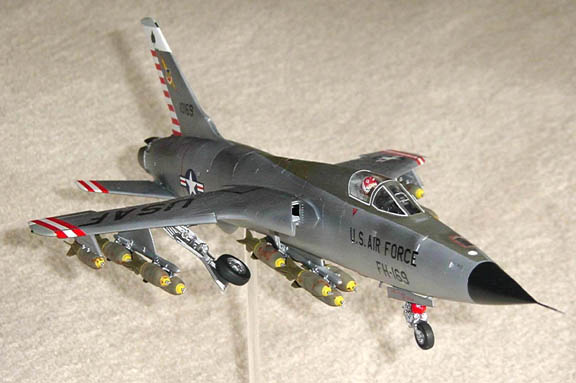
Early F-105s
Project Look-Alike painted most of the F-105’s exterior skin with aluminum lacquer to combat corrosion and brought all earlier aircraft up to Block 25 standard, correcting wiring deficiencies, adding an arresting hook, wiring for the Bullpup missile, and a boom refueling receptacle.
Not added until later were features like the radar homing and warning (RHAW) antennas on the tail fin cap and beneath the radome (not to mention the even later addition of a strike camera to the latter). Also missing were the “Rabbit Ears” (afterburner cooling scoops) and their associated base structures (often overlooked is that the inlet at the base of the vertical tail went most of the way to the fuselage before the rabbit ears were installed). The blister type anti-collision light on the spine had yet to appear (a flush installation was used instead), as had the narrow faring between the back of the spine and the vertical tail covering rerouted hydraulic lines. Also, the vents on both sides of the nose had yet to be added. The external stiffeners on the top and bottom of the wings wouldn’t be added until after the war was over. Finally, only one blade antenna was affixed beneath the cockpit—more were added as the war went on.
The InspirationDoing a model of an early D was something I’d been thinking about for a while. When I saw a photo of some 563rd TFS jets carrying loads of 16 M117 750-lb bombs in combat, I finally knew I had to act.
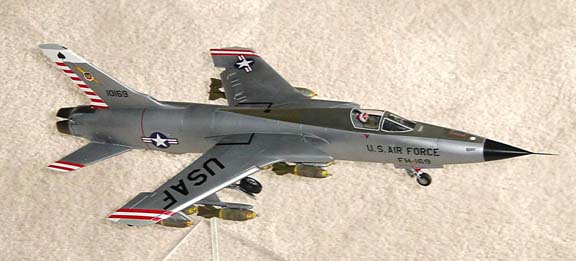
Cutting Edge did a decal sheet with their colorful markings, so I figured I was set. I didn’t feel like getting another set of metal struts and resin cockpit, so I decided to build it taking off with the gear being retracted. Since the Monogram kit depicted a post war jet, all of the above modifications had to be undone—which meant re-scribing the panel lines--Yuck!
I began to question whether or not the bright red and white stripes were actually applied to the bottom of the wings, so I queried a couple of friends knowledgeable about the F-105. One of them put me in touch with Bill Sparks, who had flown aircraft 61-0169 with the 563rd during that deployment to SEA. Bill was able to confirm that the stripes were applied to both the top and bottom of the wings and stabilators. He said they were added by the crew chiefs at Takhli, who then begged forgiveness from their squadron commander, Lt. Col. Jack Brown, for not asking permission first!I found a picture of 169 in The Republic F-105 Thunderchief, by James Geer, complete with Bill’s name on the nose gear door. (He seemed to remember that the crew chief’s name was “Tub” Wermuth.) When I researched several of the 563rd jets, I found that the one on the Cutting Edge sheet, 62-4398, had crashed due to fuel starvation on 3 Jul 65. On the other hand, 61-0169 was shot down on 28 Oct. 67 on a mission to the Doumer Bridge while being flown by the 357th TFS Commander, Lt. Col. Thomas Henry Kirk, who became a POW for the rest of the war. So, I decided to model that jet instead. When I asked, Bill told me that they had white helmets with the 563rd TFS decal on one side of a red visor while deployed—I took the liberty of adding his nickname, “Sparky” on the other side.
The HistoryA four-ship detachment was sent from Tahkli RTAFB, Thailand to South Vietnam for a week in May 1965 (first to DaNang AB and then Tan Son Nhut AB), to evaluate use of the F-105D for in-country close support and strike using various loadouts. The last two days they flew four-ship missions, three times a day, with the 16 M117 loadout. The last two missions were flown 125 miles out with a 20-minute loiter in the target area—when they returned to base (RTB), the mission commander, Al Logan reported that they only had about 1,000 pounds on initial (10 to 15 minutes of fuel left). Although the test was a judged a success, F-105s never bombed in the south again until the battle for Khe San because they were needed for bombing the bombing of North Vietnam.
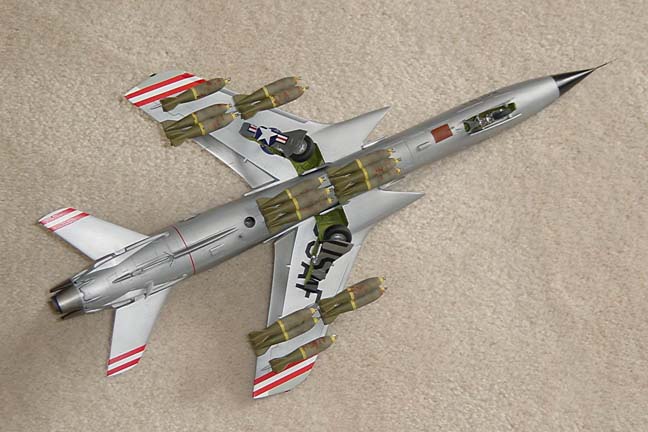
The bombs early in the war were rusted to the point that “they all looked like crap” and most should have been destroyed due to deterioration of the filler. The fuzes were World War II vintage and most had only been designed for internal carriage in a bomber. To keep them from spinning up too fast and arming the bombs prematurely, the ordnance loaders clipped the fuze vanes, and doubled the arming wires and Fahnestock clips on all the fuzes. Bill added, “We were in a sorry state for all ordnance, but Mr. McNamara didn't think we needed anything else.”
On another close air support (CAS) mission, their loadout was M118 bombs on the inboard pylons, LAU-3 rocket pods on the outboards, and a 650-gal. centerline tank. Flight lead Al Logan laughed when the FAC directed single-ship, single-bomb passes, not bothering to explain that M118s weighed 3,000-lb. each. When the first bomb detonated, the FAC said, “What the F*** was that; a nuke?” When I asked if they could really drop singles with such a heavy bomb, Bill said that level deliveries were easy, but a 4g pullout after a dive delivery “was a bitch with one on and one gone--great care was required to not do strange snaps.”
Another interesting jet the 563rd had was 59-1818. The pilot was Capt (?) Jim Rhodes, and his crew chief, Sgt. “Buddha” Fuell (?) wanted the fastest F-105 in the world. Budda waxed the entire airframe and the inlets down to the compressor face and then began drilling little holes in the engine pressure ratio (EPR) gauge line to make it read low. He kept it up until he had maximized exhaust gas temperature (EGT), fuel flow, and RPM for water injection takeoffs. When they figured out what he had done, it was computed that the thrust being generated was in excess of 31,000 pounds in the takeoff setting of afterburner with water injection (normal was about 26,000)! Budda indeed had the fastest bird in the world; it would cook along at 0.99 Mach in MIL power and was “truly fast” in afterburner. The engines didn't last too long, “but it would haul ass”. It was lost on 25 Aug. 69, along with its pilot, Maj. Steven Roy Sanders, during a Barrel Roll mission (in northern Laos) while making a strafing pass after five bombing passes on enemy troops.
Academy F-86
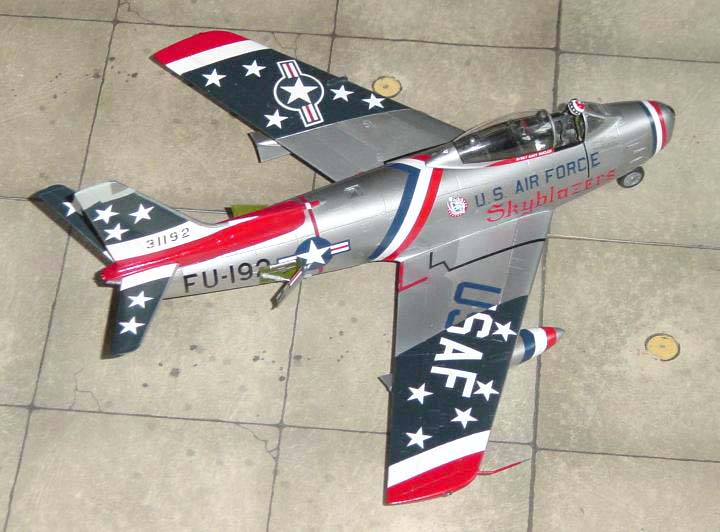
F-86F: This is the team leader’s aircraft for the 1956 Skyblazers, USAFE’s aerobatic team during the 1950s. The team was part of the 48th FBW, which was based at the time at Chaumont AB, France. This is the Academy kit with the KMC cockpit, Techniks metal struts & pilot helmet, and Cutting Edge decals. Metal finish is primarily Alcad II Semi-Matte Aluminum and White Aluminum, with Model Master metalizers on the aft fuselage. Kit modifications include: Hypodermic tubing replaced the wing pitot tube, Modified the lower speed brake hinges to correctly reflect their droop when open, Cleaned up the inlet to remove the seams and the kit’s nasty nose wheel well box, Corrected the nose wheel well opening to match the gear doors. Check out the pilot’s helmet!
Hasegawa F-104
F-104N: This model is of the ill-fated F-104N flown by NASA test pilot Dr. Joe Walker 8 June 1966, when it was sucked into the wingtip vortices of XB-70-2, destroying both aircraft, killing Dr. walker and Maj. Carl Cross in the Valkyrie. It is the 1/48th Hasegawa kit with the Meteor cockpit. The decals are from the 2001 Chicago Convention Sheet, which unfortunately required quite a bit of reworking to yield an accurate model. Metal finish is primarily Alcad II Aluminum with Model Master metalizers on the aft fuselage. Kit modifications include Fairing over the cannon port and Hypodermic tubing replaced the pitot tube.
MiG-17F Fresco C 2072, 921stt Sao Do (Red Star) Fighter Regiment, Noi Bai AB, North Vietnam (NW of Hanoi)
1968: “There’s Snakes in the grass in Banana Valley…”
Trumpeter 1/32 MiG-17F
Cutting Edge MiG-15 cockpit & MiG-17 ejection seat, Cutting Edge MiG-15 landing gear & wheel well/inlet splitter,
Canopy is a never released prototype from Cutting Edge, Custom decals produced by Mike Grant,
Gun barrels & pitot tubes are hypodermic needles, Tail warning RHAW antenna scratch built, Intake scratch built
Speedbrake interior scratch built and shape corrected, Rear fuselage contours corrected, Ventral fin scratch built
Afterburner extended & petals scratch built, LOTS of weight added to nose!!
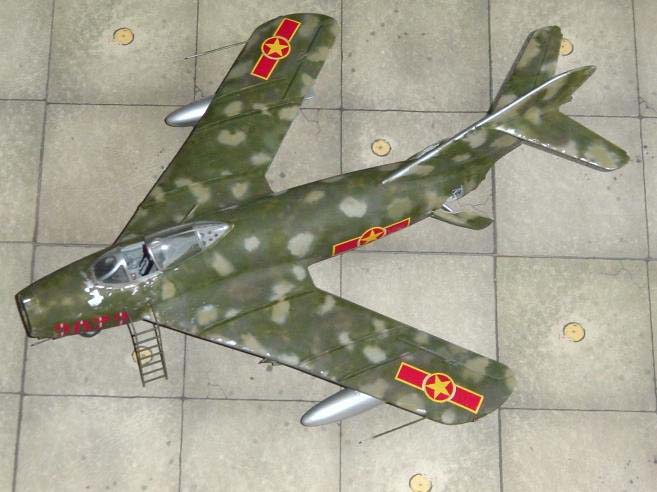
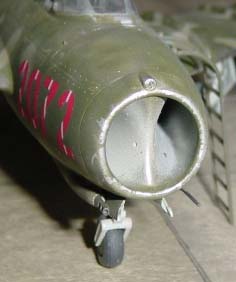
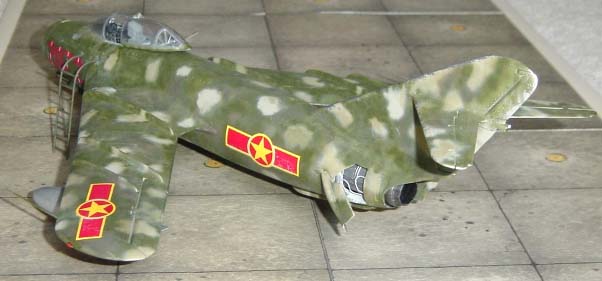
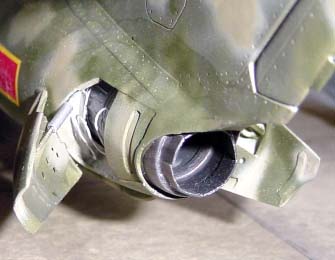
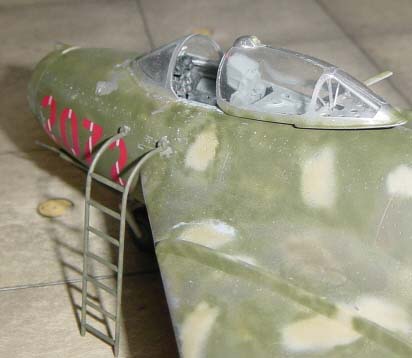
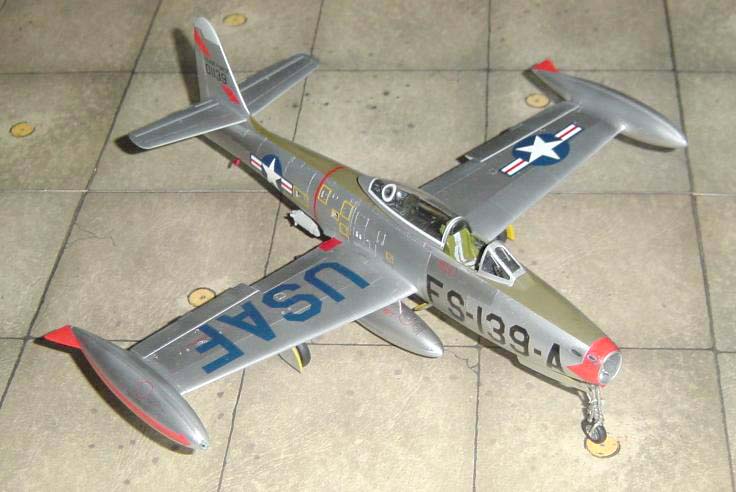
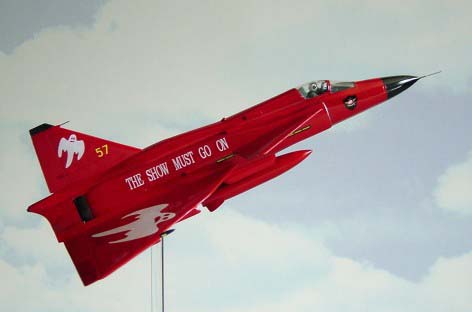
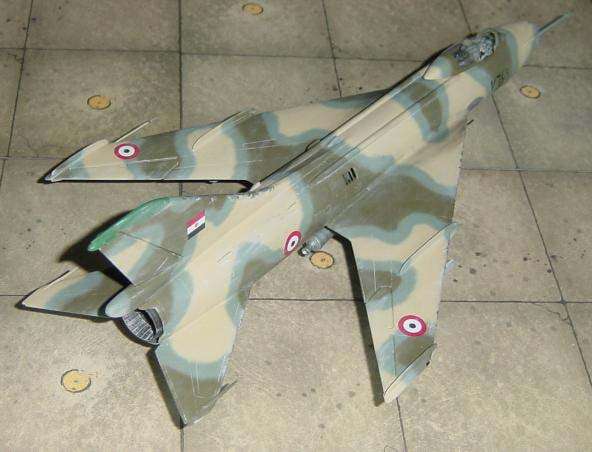
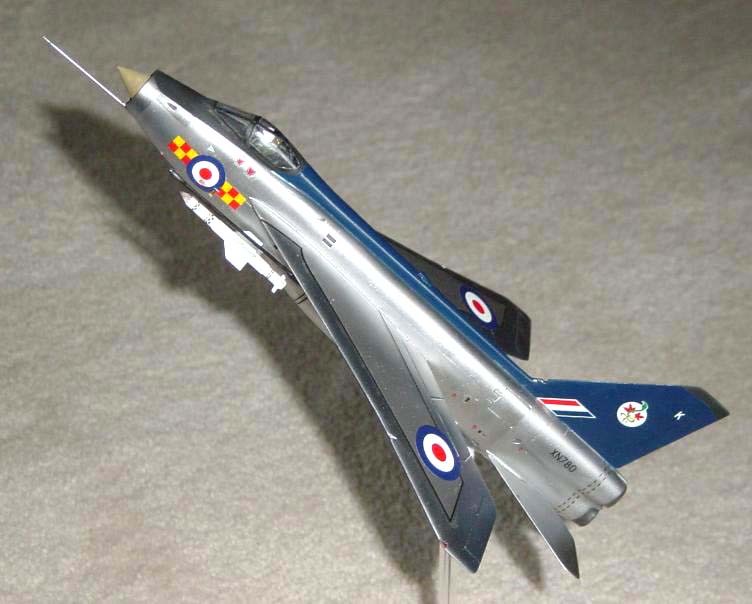
As you can see Jim likes 'em flying
Jim Rotramel dropped by again with another corker for you enjoyment
this time it is Italeri's B-58 Hustler
Last Page
Airbase
What's New
Home
Reviews
Next Page